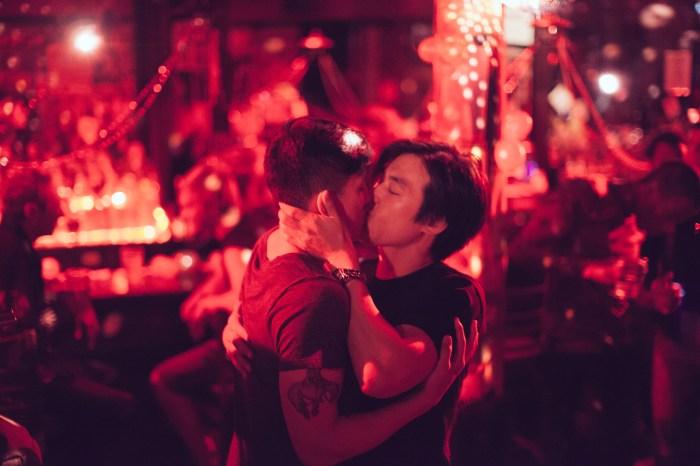Joaquin Phoenix and Philip Seymour Hoffman in Paul Thomas Anderson’s “The Master.” | THE WEINSTEIN COMPANY
Paul Thomas Anderson made his first three films in three years. Since then, the gaps in his filmography have grown increasingly large. It’s been five years since his last film, “There Will Be Blood,” and his current one, “The Master.”
There’s less and less room in American cinema for the kind of adult-oriented filmmaking Anderson favors. Robert Altman seems to be Anderson’s biggest influence, but after the ‘70s, Altman himself was out of favor with the studios; his best ‘80s film, “Secret Honor,” was made in collaboration with a college class. By Hollywood standards, Anderson’s budgets are relatively low, but he’s not making the kind of films with five-figure budgets that could be partially raised on Kickstarter.
Much of the buzz around “The Master” has revolved around the similarities between the Cause, a quasi-psychoanalytic organization founded by Lancaster Dodd (Philip Seymour Hoffman), and the early days of Scientology. I was more struck by the ways in which Anderson has started to repeat himself. He comes very close to recycling imagery from his 2002 comedy “Punch-Drunk Love,” except that there’s nothing funny about the anger and violence expressed in “The Master.”
When “The Master” begins, Freddie (Joaquin Phoenix) is serving in the Navy in the final days of World War II. An alcoholic prone to violence, he drifts through a string of jobs after his release from the military. He first meets Lancaster when they get into a fight while Freddie tries to take the older man’s photo. After Freddie gets in trouble for concocting a toxic brew of booze, he takes refuge on Lancaster’s boat and becomes part of Lancaster’s crew, participating in the Cause and living in his house.
This is the first film in which Phoenix is really convincing as a middle-aged man. Here, his looks are in the process of fading, and he seems about ten years older than his actual age. The quasi-documentary “I’m Still Here,” in which he played himself as a perpetually stoned, talent-free rapper wanna-be, showed he has little vanity. “The Master” confirms it, but it also reveals a raw intensity new to Phoenix’s work. His voice sounds like it was squeezed out of his vocal cords by force.
Although Anderson cast actresses as talented as Laura Dern and Amy Adams, he didn’t give them much to do. “The Master” is a guys’ movie. While there are no gay characters, unlike Anderson’s “Boogie Nights,” there’s a greater homoerotic charge between Freddie and Lancaster than I’ve ever felt between two men in an Anderson film. The Cause gives them an instant intimacy, as Lancaster gets to ask Freddie about his sex life. However, their relationship remains unequal — one of master and servant or, at worst, owner and unruly pet. Lancaster manipulates Freddie and, in the end, Freddie uses what he learns to manipulate women.
Rebelling against an all-digital future, Anderson shot “The Master” in 65mm. It will be shown in that format in several theaters around the city. (The only other recent film shot in 65mm is Ron Fricke’s documentary “Samsara,” and the Landmark Sunshine is showing that on digital video, albeit with very high quality projection.) Anderson says he wanted to capture the look of ‘40s and ‘50s Hollywood cinema.
“The Master” is no retro pastiche, however. At first, it seems to be aiming for something akin to “Mad Men” or Todd Haynes’ “Far From Heaven” — capturing the past with all the knowledge and freedom of the present. Haynes made a film that Douglas Sirk might have if he’d been able to openly depict gayness. The opening lines of “The Master” are about STDs, and the film is frank — to the point of being crude — about sex in ways that no Hollywood film made in the ‘50s could have been. All the same, that’s not its real agenda.
“The Master” is centered on a number of set pieces between Lancaster and Freddie. In one, Lancaster asks Freddie a series of embarrassing questions while ordering him not to blink. In another, Freddie demolishes a jail cell while Lancaster, confined to the next cell, urges him to calm down. These scenes are among the most powerful I’ve seen this year. Unfortunately, they suck all the oxygen out of the rest of the film.
When Freddie’s not in a rage, “The Master” suffers. It also doesn’t benefit from seeming like a partial reprise of “Punch-Drunk Love,” where Adam Sandler’s character dealt with many of the same issues. Anderson got a great performance out of Sandler, something I never dreamed possible, and he gets one out of Phoenix here. But for all the passion mustered by Phoenix, the final third of “The Master” grinds to a halt. The Cause purports to offer visions of past lives, but it can’t offer a satisfying ending.
THE MASTER | Directed by Paul Thomas Anderson | The Weinstein Company | Opens Sep. 14 | Citywide



































